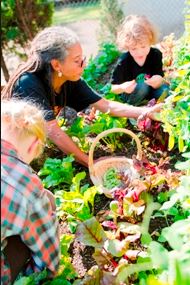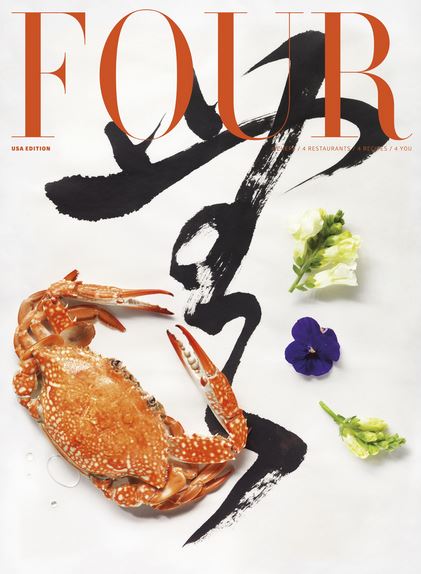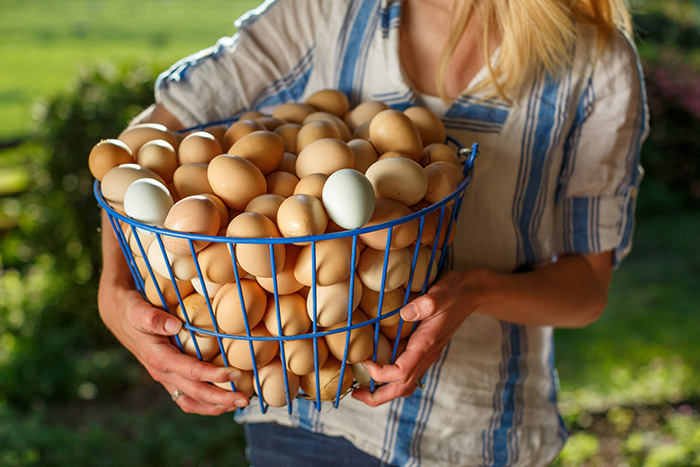Powerful Medicine: A Garden Gives Portland’s Native Community a Place to Call Home

Edible Portland, Spring 2013
Rose High Bear’s silver-streaked braid swings from side-to-side as she glides beneath a canopy of cathedral-like red cedar trees. Leafy huckleberry and high bush cranberry sprout to her right. She points to elderberry and salmon berry, then pauses near a circle of freshly cut cedar rounds arranged as stools.
“The talking circle is the most recent addition to the Wisdom Gardens,” she says. High Bear calls this garden, tucked into outer southeast Portland, “horticultural therapy.”
“My community needs this,” High Bear adds. “When you look at the social determinants of health in Portland — everything from poverty and education to healthcare and the environment — [Native Americans] are at the bottom of the list.”
In 1993, High Bear, who is Deg Hit’an Dine (Alaskan Athabascan), and her late husband, Lakota medicine man Martin High Bear, founded the nonprofit organization Wisdom of the Elders. Today, she acts as executive director, overseeing cultural outreach, community and healing through storytelling programs, radio broadcasts and, most recently, the Wisdom Gardens.
“We serve Portland’s Native community — of which there are about 40,000 in the greater metropolitan area,” she says. Portland is the ninth largest Native community in the United States, with more than 350 tribes represented.
Portland’s diverse population of Native Americans is partly the result of the Indian Relocation Act of 1956. This federal initiative, which was designed to encourage Native Americans to leave their tribal lands for one of seven designated urban centers, resulted in more than half of the U.S. Native population settling in cities for promised opportunity. The social experiment is one of many factors contributing to large-scale displacement and cultural disintegration for many tribal members today.
The Wisdom Gardens was born from the desire to educate and nourish Portland’s tribal community on the importance of Native foods and help build their sense of home. The project took root in the spring of 2012 on a one-third-acre plot owned by Wisdom of the Elders and a nearby organic garden at Earl Boyles Community Garden provided by Portland Parks and Recreation.
“The gardens were developed almost exclusively by volunteers,” says High Bear. A grant from East County Soil and Water Conservation District funded the purchase of Northwest native plant species for ethnobotanical and berry plantings, and Portland Nursery donated a medley of heirloom vegetable seeds from peppers and Japanese peas to golden beets, beans and squash.
“What you eat is powerful medicine,” says Marc Anderson, an environmental engineer and diabetes educator who serves on the advisory committee for the Wisdom Gardens. A member of the Seminole tribe, he has a family history of type 2 diabetes that inspired him to transition to a mostly vegan diet and reclaim his health. He now advocates for a diet of traditional plant-based foods for Native Americans to reverse diabetes.
High Bear and Anderson met when he returned from a trip to Santa Fe with a gift of heirloom seeds from the Navajo Nation. Seeking a home for the seeds — a trio of blue and red heirloom corn, beans and squash that celebrates an Iroquois legend known as Three Sisters — a mutual friend suggested he donate them to the Wisdom Gardens. Today, the garden brims with foods native to Pacific Northwest tribes, while integrating staple produce from other tribal regions.
In less than a year, more than 100 guests have visited the gardens for open houses and harvest celebrations, and close to 50 volunteers have contributed by digging in the dirt, planting, pruning and harvesting. Wisdom of the Elders funded two scholarships for long-term volunteers to attend Oregon State University’s Master Gardener training, and both volunteers are now working in the garden to share what they learned with the Native community.
“What we’ve been trying to do at Wisdom Gardens is convince the Native community to come into the garden,” says High Bear. “Get your hands dirty, reconnect with the earth. Because no matter where you are on Mother Earth, you are at home. She’s our oldest grandmother. And this is where we need to reconnect.”
Food gathering is also an integral part of the social fabric for tribes, whether berry picking in the mountains, harvesting roots, or hunting game and fishing. “Whenever we went to harvest, there would be stories and oral histories told — so much teaching went on,” says High Bear.
At the end of the fall harvest season, Wisdom Gardens brings elders and the community together to make elderberry syrup, while sharing stories and ancient skills. “Most precious berries have to be cooked; you can’t eat them like a wild strawberry or huckleberry,” says High Bear. “It takes wisdom to know this, and preferably a grandma to teach you.”
Tribes across the Pacific Northwest are working to reestablish food sovereignty and integrate native, local, healthy and culturally appropriate foods into their daily diet. The U.S. Department of Health and Human Services reports that American Indians and Alaska Natives are 2.2 times more likely to have type 2 diabetes than non-Hispanic whites. From 1994 to 2004, there was a 68 percent increase in diabetes in American Indian and Alaska Native youth aged 15 to 19 years.
Many tribes are now funding initiatives that increase access to traditional foods to help battle the diabetes epidemic. The Confederated Tribes of Siletz Indians, with a membership of close to 5,000 and ancestral lands that spread out like a patchwork quilt near the Central Oregon Coast, is one of seventeen tribes in the nation instituting a Healthy Traditions project, funded by a four-year type 2 diabetes prevention grant from the Centers for Disease Control (CDC) to restore traditional foods culture.
The goal of the project, which began in early 2010, is to improve the health of tribal members with educational activities that promote the use of traditional foods through hunting, gathering, cooking, food preservation and protecting natural resources.
“We first held community meetings and asked tribal members: What do you need; what is most important to you?” says Sharla Robinson, Healthy Traditions Project Coordinator. “The response was for gardening programs, more classes and community learning,” she says.
For the past three years, Healthy Traditions has primarily focused on outreach education and hosts an average of six events per month among four area offices: Siletz, Eugene, Salem and Portland. “Each office acts like a community center for the tribe,” says Robinson.
The seasonally inspired classes, ranging from slow cooker cooking and canning tuna to jerky making and pickling, also focus on bringing families together. At a recent storytelling and cooking class in Siletz, three generations of one family made a meal together. Partnerships with outside organizations give members the opportunity to enroll in master gardening classes through the Oregon State University Extension program or hunter education classes with the Oregon Department of Fish and Wildlife.
The Siletz tribe also pursues and develops relationships with private and public landowners to secure spots for annual harvests of traditional foods, such as huckleberries and camas, and in exchange, to contribute to the management of those lands. Each summer, a group of tribal members caravans to the Cascades to harvest wild huckleberries from a patch they help maintain in partnership with the Sweet Home Ranger District.
“One of the greatest challenges is access to Native foods,” says Robinson. The most common barriers are exclusion from areas where traditional foods live and grow, and environmental degradation in harvest areas due to logging, pollution and industrial farming.
The long-standing tribal lamprey harvest on the Siletz River now occurs just once a year at Willamette Falls, as the local lamprey runs have diminished to the point of nonexistence in many traditional areas. Each spring, the Siletz tribal biologist floats six tribal members to a spot in the falls, where they traverse rocks, swim in the water and then dive for lamprey.
The tribe in turn works with the Oregon Department of Fish and Wildlife on efforts to increase the passage of lamprey at the Siletz Gorge falls, tagging fish and monitoring their movement over the falls and ladder. Stewardship is a core thread in the dialogue surrounding food sovereignty for many tribes.
“Traditionally your whole day was filled with food-related work. Whether you were traveling to harvest, chasing after game, or cooking food, it was a whole family process,” says Robinson. “It is important because there was also a relationship to the land,” she adds. “It was a part of you.”
Robinson leans forward to share a story she’s been told by elders about the now-elusive camas fields. A traditional prairie plant, the bulbs were a staple food for her ancestors. When Lewis and Clark first encountered the endless fields of flowering camas out West, Meriwether Lewis wrote that the lush blooms “resemble lakes of fine clear water.”
“That was how thick the camas grew,” says Robinson. Now when the tribe harvests camas, they only gather it once a year for a summer solstice ceremony dinner, because it is so limited. “We take a place into ourselves and in turn, we give back.”
Where we live is so much more than just a place, adds Robinson. As tribal nations have been removed from their homes, there is a loss of that personal relationship to place. Food sovereignty works to reignite that connection.
“There is definitely a movement happening across the Northwest around traditional foods in tribal communities,” says Valerie Segrest, a Native foods educator and community nutritionist with the Muckleshoot Indian Tribe, located 30 miles southeast of Seattle.
Segrest teaches a course at the Northwest Indian College called “Honor the Gift of Food,” a basic nutrition curriculum that empowers students to develop a healthy, traditional foods-based diet in a modern world. She encourages students to ask themselves, as they walk through modern day grocery stores, what would your ancestors recognize as food?
As students get creative, traditional foods with a modern twist yield dishes such as salmonberry sorbet with wild rose honey, salmon hash, kelp pickles, rosehip jam and nettle pesto. In addition to teaching, Segrest manages the Muckleshoot Food Sovereignty Project — an initiative that spans Native teaching gardens at the college, a community food assessment and monthly hands-on seminars, such as traditional salmon preparation and skin tanning.
One of the spiritual principles Segrest speaks to in her curriculum is: Cook and eat with good intention. “In our culture, cooking food for people is one of the holiest things you can do. If you have a stranger in your home or a friend, you sit them down and you offer them food,” she says. As you prepare the food, you are supposed to hold good thoughts on how you want people to feel when they are eating the food you prepare.
We have such a deep relationship with food, says Segrest. “As we make this shift to a healthier, more abundant food system, feeding the spirit has to be part of the conversation of how we create sustainability,” she says. “When we ask people to change what they eat, we are really asking them to change their values,” Segrest explains.
“One thing that I’ve learned in all of this is that with each challenge comes an opportunity,” says Segrest. “These are opportunities for people to come together and make a difference, to be change agents in their food systems. And that’s really the healing we are looking for.”




